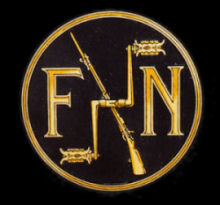


Collection: Museum of science and technology Stockholm

A four-cylinder F.N. altered to give a very low riding position. The petrol tank, it will be observed, is underneath the engine.
1910 Stanley Show Report
F. N.
One of the most interesting exhibits at the Stanley Show is to be found on stand 56, which contains a good display of the famous F.N. motor-bicycles. The 1911 5-6 H.P. four-cylinder F.N. contains a large number of interesting features, while the price, viz., 50 guineas, including foot-rests, is approximately the same as a high-grade cycle cylinder model, and less than some twin-cylinder machines. It is now nearly five years since the first gear-driven four-cylinder F.N. motor-cycle was introduced, and its increasing popularity proves that it is giving every satisfaction.
For 1911 the engine has been entirely re-designed, and is now rather more powerful, the bore of each cylinder being 52.5 mm., the stroke remaining at 57 mm, as before. The ports for the sparking plugs are formed on the right-hand side between the inlet and the exhaust valve ports, so that over-lubrication does not now always mean dirty plug troubles. The crankshaft is now carried in phosphor-bronze bearings, and a needle valve compression cap occupies the place in each cylinder where the sparking plugs were placed in the older models.
Perhaps the chief improvement, however, relates to the automatic carburetter, which, fitted in conjunction with a branched induction pipe, ensures phenomenally slow running, and the machine can actually be ridden at a walking pace. Being automatic in action, one lever suffices to control it; moreover, it can be detached in a few moments and dismantled in the same time.
The revolving portion of the distributor has been improved, having a brass tubular guide for carrying the carbon brush, the terminals of the outer casing being of the ball type for push-on terminals. No fly-wheel covering is now fitted, but an annular oil connecting ring is fitted behind the end bearing of the crank shaft, with a lead-off pipe, pointing upwards and downwards. Any excess of oil is collected in the annular ring, and flows away by means of the pipe. The transmission remains very much the same as before, with one important exception, and that is, that the gear wheels are now made from chrome nickel steel. The gear ratio is 5.25 to 1. A new system of locking the transmission casing has now been embodied. In its improved form this famous machine should be more popular than ever amongst all classes of motor-cyclists.
Cycle and Motor Trades Review
F.N. Four Crankshaft
A sectional view of the F. N. four-cylinder engine, which shows the practical application of a five-bearing crankshaft and the arrangement of the crank-pins, so two pistons are going down while the other two are on their up stroke, is presented at Fig. 68. It will be noticed that the Henderson crankshaft, while it has four crank throws, is a three-bearing form, having one main journal at the center and one at each end, whereas the F. N. design has a bearing between all crank throws as well as at the ends of the crankshaft.
Motorcycles Sidecars and Cyclecars, 1914, by Victor Page